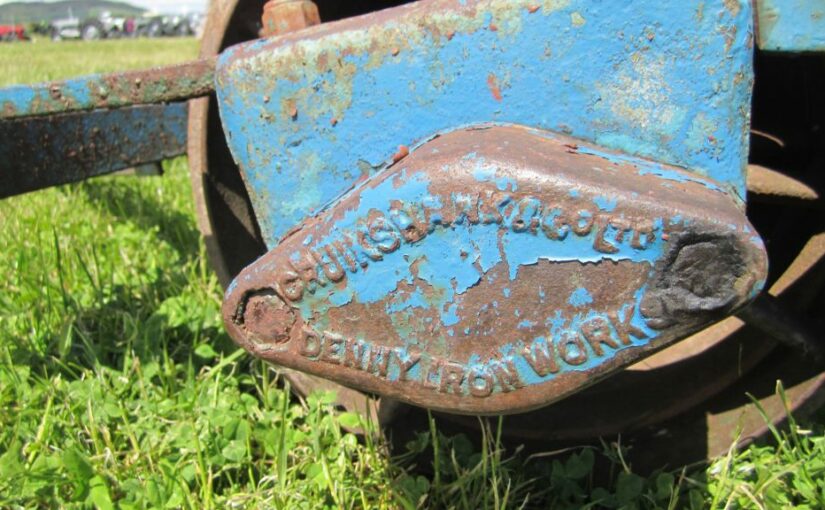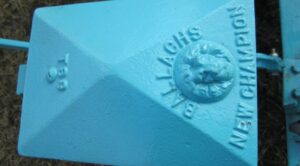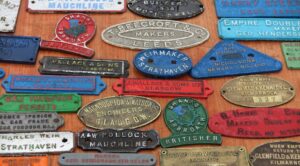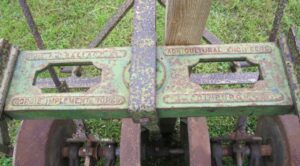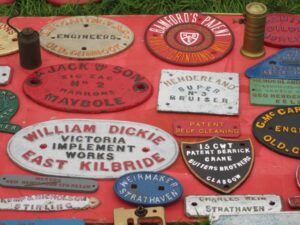As noted in an earlier post the “New Implement” was an important aspect of the Highland Show. In 1937 there was a particularly strong entry for the award. Some of the entries were from well-known and long established businesses, such as Cruikshank & Co. (Ltd), Denny Iron Works, Denny, J. L. & J.Ballach, Gorgie Implement Works, Edinburgh, and Alexander Jack & Sons (Ltd), Maybole. Others were introduced by inventors who had a good idea that would help to support the mechanisation of Scottish agriculture.
The Scotsman published an extensive account of the entries in its pages of 22 June 1937. Here is what it said about the Scottish entries:
“The Highland Show at Alloa
New Implements
The competitive section
This year there are no fewer than 18 entries for the Society’s silver medal for new implements, as compared with 10 at Melrose last year and 13 at Alloa in 1929.
One or two of the entries are improvements on existing implements, and several are of labour-saving devices, which bring them into the category of new implements. The Society does not bind itself to try in the field every new implement, but an exhibitor who expresses a wish to do so can, with the sanction of the steward of implements and at his own expense, take his new implement out of the showyard during show week and put it to work, and, if within a reasonable distance, the judges will, if they deem it necessary, inspect it at work, and decide if it is worthy of a silver medal.
The judges of new implements are Mr J. P. Ross-Taylor. Mungoswalls, Duns, chairman of directors of the Society, who is also steward of the implement sections; Mr James Paton, Kirkness, Glencraig, Fife; and Mr John E.B. Cowper, Gogar House, Corstorphine, Edinburgh.
Mobile grass drier
One of the novelties in the show, a mobile grass drier invented by Messrs R. H. Rowell, Thomas Sanderson, and D. H. Sanderson, has been entered for competition by Mobile Driers (Ltd), Newcastle-upon-Tyne. Radiant heat is used in order to bring the moisture content of the grass to such a temperature that expansion takes place, thus liberating the moisture from the cellular tissue, which comes away in the form of vapor. It is then carried away by a convection current introduced from the bottom. As the convection current rises it meets the driest grass first, and, as it ascends, that which is less dry passing through the layer of grass on the various conveyor belts, and finally passing out fully saturated at the open top of the machine.
The principal advantage of this method of using radiant heat as a drying medium is exemplified by the fact that although the temperature of the saturated or partly saturated air drops very considerably (due to the latent heat of evaporation), the radiant panels still retain their full heat, being unaffected by the temperature of the surrounding air. The grass on each conveyor is subjected to radiant heat emission both from above and below the intensity of the radiant heat on the various conveyors being regulated; the wet grass is subjected to the greatest intensity, and this is diminished on the lower conveyors as the grass approaches a state of dryness. By this means a higher thermal efficiency is obtained than is possible where only a convection current is used.
Mobility of unit
The grass is taken up on an elevator and dropped on to the travelling conveyor belts to a thickness of approximately 4 ins, and the cascaded five times from one belt to the next below it before being automastically ejected in twelve minutes, this being the average time taken to dry grass which requires to have extracted moisture composing 80 per cent, of its total weight. The transmission, mounted upon a chassis, takes the drive direct from the source of power, which is usually a tractor or traction engine. Each unit is mounted on a pneumatic-tyred wheeled chasis and can be moved from farm to farm, or, if necessary, from field to field.
Bracken cutting scythe
A bracken and thistle cutting scythe has been entered by Cruikshank & Co. (Ltd), Denny Iron Works, Denny. This invention had been designed for use in accessible places, where it is impossible or dangerous to operate horse-driven or motor-driven cutters because of rough, wet, or steep land, or of trees and rabbit warrens. The scythe consists of two blades, each having a concave cutting edge resembling sickles placed back to back, which are fixed by means of a socket to a central Y handle, and weighs 5 ½ lbs. It is claimed that by means of the scythe large numbers of unskilled workers could be equipped at a moderate outlay for cutting large areas of bracken-infested land cheaply and expeditiously.
Spuds for mower wheels
Messrs J. L. & J.Ballach, Gorgie Implement Works, Edinburgh, exhibit “Sure-Grip” spuds for hay mower wheels. They have been designed for renewing worn hay mower wheels which have lost their gripping power. The centre rib on the spuds minimises slip on sidelands, and also ensures smooth transport on roads. The cost of supplying and fitting the spuds is about half the cost of new wheels. The spuds are easily fitted.
Hay-stacking elevator
Mr Robert Fraser, Threapmuir, Fossoway, Rumbling Bridge, has entered a haystacking elevator of his own invention. The chief feature of this elevator is that it can be easily controlled by one person. It can also be worked as long as desired without any risk of choking. The engine is enclosed, and is thus kept free from seeds &c. The elevator can be fitted with Dunlop wheels at small extra cost.
Glasgow firm’s devices
Three entries have been made by Messrs W. Henderson & Sons, Kelvindale Road, Glasgow. One is the “Collins” anti-slip wheel device, for fitment to pneumatic-tyred tractors and other vehicles. The fitment imparts a caterpillar or feathering action, whereby the loss of power is reduced to a minimum. The second is a harrow, the purpose of which is to provide a means of cultivation for various operations at present requiring a specialised machine or tool for each different operation. The third is an improvement in implements for fitment to “Collins” junior bracken cutter.
Ayrshire machines
A new three-row combined drill plough, artificial manure distributor, and dibbler or spacer is exhibited by Alexander Jack & Sons (Ltd), Maybole. This new machine represents an advance in the methods of cultivating potatoes and turnips, and is designed to increase the speed of planting without employing additional horse-power or manual labour. The same firm exhibits an improved three-row drill cultivator, with shafts for one horse. It is claimed that it can do the same work as three men and three horses with single-row cultivators or hoes.
Soil aerator
Mr John Hutton, Lemonth, Crail, Fife, shows a soil aerator, invented by exhibitor and made by D. Colville Carr, engineers, Crail. The main feature incorporated in the aerator is to be found in the movable tines. By a slight twist of the handles-which also serve for pulling the instrument-two tines come into operation in the space between each plant. As a plant is approached a twist of the handles in the reverse direction throws the two moveable tines out, and thus allows the plant to pass between.
All-crop harvester
Alexander Strang (Tractors) (Ltd), 4 Duddingston Gardens South, Edinburgh, exhibit the “Allis-Chalmers” all-crop harvester-a machine for cutting and threshing crops in one operation. It is claimed to be a machine new in threshing principles, in shape, and in design, and entirely new in results, a machine designed to suit all territories and all crops.
Animal feeding trough
An animal feeding trough, invented by Mr A. B. Allan, Auchinleck, Newton Stewart, and made by Mr John Rutherford & Sons, engineers, Earlston, Berwickshire, is exhibited by Messrs Gillies & Henderson, Bread Street, Edinburgh. This trough has an ingenious locking device. While the animals are feeding the trough is held in a locked position, but when the feeding stuffs have been consumed the trough is automatically turned upside down. This locking device ensures that the trough will be kept perfectly dry, and this prevents feeding stuffs from becoming damp.
Refrigeration plant
Messrs G. D. L. Swann & Son, Abercorn Street, Glasgow, have entered a pulsometer refrigeration plant, invented by a Reading firm. The plant is a methyl chloride refrigerating plant for cooling milk at approximately 45 gallons per hour under normal weather (summer) conditions from 90 degs F. to 40 deg F. It is in the design of the milk cooler itself that an advance is claimed. The design, viewed mechanically, is considered to be the best for withstanding internal pressure-i.e. a cylinder. No corrugated cooler could withstand so great a pressure.
Milking machine
Messrs Swann & Son also exhibit the Hinman-Simplex milking unit. The special improvements claimed, for recognition include the extreme simplicity of the design, which makes it possible to dismantle and re-assemble the whole unit, including the pulsator (patented) by hand only, no tools whatever being required.”
